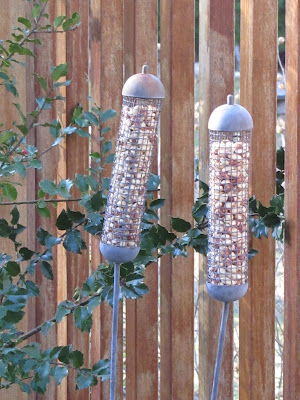Collect pine boughs and other greens and insert them deep into the soil of the pot. If it is already frozen just add some hot water until it softens enough to insert the branches and it will freeze again to secure them tight.
We were lucky enough to make use of a young holly tree that our neighbor had cut down in his yard and had thrown on our shared burn pile to set ablaze in the spring. We were actually quite sad that he cut the beautiful tree and made sure it went to good use .
So it become part of our bird haven and we will decorate with loads of holly this season.
The haven is in the corner of our deck opposite one of the kitchen slider doors, where we will have constant viewing of our feathered friends while we gather in the kitchen.
Two cattail feeders were inserted into another pot next to the holly and filled with shelled peanuts. The birds love them and it's great energy source for the colder months. The feeders can also hold sunflower seeds. We bought them here. White pine boughs complete the pot offering birds cover and a place to land .
Our haven wasn't even complete and we already had visitors! Peanut lovers!
There was even a "sweet birdy" walking around the pot waiting for any fallen remains.
We set this up for the ground feeders, filled with Safflour seeds, which squirrels do not like.
Another pot we just filled with greenery for now. The birds can hide in there.
We also used a cedar branch we had saved,
inserted it deep into a five gallon bucket filled with soil. We covered it with rocks and added greens. We wired it to the deck rails to keep it upright and sturdy in heavy winds and concealed the wire with pine boughs. And now it holds suet feeders.
It is another terrific spot for viewing and we have easy access to refill the feeders.
I am especially excited to relax in the kitchen with my coffee or tea while watching the various birds.
The Bird Haven also makes for some great entertainment for others in our household.
See if you can set up a Bird haven at your house!
Below is some helpful information about the different bird seeds and who likes what:
Below is some helpful information about the different bird seeds and who likes what:
- Black Oil Sunflower Seeds are a premium feed. Most birds prefer them to the striped sunflower variety. Sunflower seeds a high energy and nutritious food source packed with protein and fat and leave less waste than some other seeds.
(Gold Finches, House Finches, Purple Finches, Cardinals, Bluejays, Scrub Jays, Chickadees, Nuthatches, Titmice, Mourning Doves, Buntings, Grosbeaks, Juncos and Sparrows eat sunflower seeds.)
-Thistle seeds (Niger) : nutritious seed rich in protein and fat. Thistle feeders with tiny openings limit attracted birds and squirrels do not like Thistle (it's debated).
(Goldfinches, House Finches, Purple Finches, Redpolls, Siskins, Juncos, and even Mourning Doves eat thistle seeds.)
-Safflower Seed: High in protein and fat.
Cardinals, Mourning Doves, Finches, Grosbeaks, Jays, Chickadees, Nuthatches, Titmice, Song Sparrows, and White-throated Sparrows like Safflower. Squirrels dislike safflower seeds. So this is a good option for those wanting to discourage unwanted "visitors".
- Peanuts: Feeding shelled unsalted peanuts isn't messy and they are highly nutritious for the birds that can eat them. Most birds can shell whole (unshelled) peanuts, with varying degrees of effort.
Squirrels love peanuts. However, do NOT feed RAW peanuts to squirrels and other animals because it can seriously hurt them. Raw peanuts and other legumes contain a trypsin inhibitor or substance that inhibits or prevents the pancreas from producing trypsin, an enzyme essential for the absorption of protein by the intestine. Squirrels fed a steady diet of raw peanuts, soybeans. other legumes, and sweet potatoes could easily develop severe malnutrition.
Roasting hulled raw peanuts for 20 to 30 minutes at 300 degrees Fahrenheit, stirring them frequently, will destroy the trypsin inhibitor and render them suitable for feed. If that sounds like a lot of work, buy roasted peanuts but be sure they aren't salted. (Salted nuts of any kind should never be fed to wild animals.)
( Bluejays, Scrub Jays, House Finches, Cardinals, Woodpeckers, Magpies, Chickadees, Nuthatches, Titmice, White-crowned and White-throated Sparrows eat peanuts.)
happy day!
















6 comments:
Marcia,
This is such a wonderful post. We have many bird feeders but I hadn't heard of setting up a sanctuary in the flower pots. We'll do that this week. Also thank you for the primer on birds and which foods they like to eat. Be well.
Beautiful ideas.;) Birds do suffer in winter and here winter has arrived way too early with 20 inches snow.;)
have a lovely weekend,
xo
Those are some great ideas, we may have try some and will let you know how they turn out!
Thanks for sharing,
G
I LOVE this idea!!!!! I somehow missed this post and I'm so glad I came over to revisit, after falling behind.
you always have such clever, original ideas.
Pop this one into the next Project Genesis in Feb Ok? I really think others might try this.
: D
xxx
z
Ooo! I love this idea -- so easy, resourceful, green and positive. Thank you!
And for others reading along, if you look through the post I wrote - http://traininghappyhearts.blogspot.com/2010/02/works-for-me-wednesday-vol-2-homemade.html - you'll fins a local bird spotting bingo sheet you can print. My kids loved it last year. Enjoy!
wHAT A Wonderful Bird Haven!
FEED THE BIRDS...you certainly do.
Thank you for this lovely post and the information on food and see is so useful ;-)
It must be hard to steal yourself away from the window
Happy December Days...
LOVE PEACE enJOY
Julie
x
Post a Comment